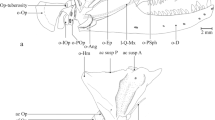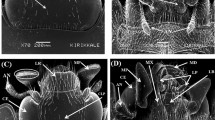Abstract
A detailed account of the structure and musculature of the mouth tube and mode of feeding in P. narcinae is presented. The double-walled mouth tube is formed by a close fitting of the lateral, longitudinal ridges of the labium into the longitudinal groove of the inner, lateral edges of the labrum. The musculature of the mouth tube consists of two pairs of retractores oris, four pairs of compressores labri and two pairs of levatores labii. The host tissues are scraped off by the mandibles repeating a very characteristic movement brought about by roto adductor mandibulae and roto abductor mandibulae pair of muscles. The tissue particles are forced into the buccal cavity with the help of labral muscles. The suction is broken by the contraction of levatores labii group of muscles.
Similar content being viewed by others
References
Boxshall, G. A., 1986. The comparative anatomy of the feeding apparatus of representatives of four orders of copepods. Syllogeus, 58: 158–169.
Fryer, G., 1982. The parasitic Copepoda and Branchiura of British freshwater fishes. A handbook and Key. Freshw. biol. Ass., Sci. Publ., 46: 1–87.
John, S. E. & N. B. Nair, 1974. Functional morphology of the mouth tube of Hermilius longicornis Bassett-Smith, a parasitic copepod on Ariodes dussumieri Valenciennes. Monit. zool. ital., 8: 133–140.
Kabata, Z., 1970. Crustacea as Enemies of Fishes. In S.F. Snieszko & H. R. Axelrod (eds), Diseases of Fishes, Book I. T.F.H. Publ., NJ, 171 pp.
Kabata, Z., 1974. Mouth and mode of feeding of Caligidae (Copepoda), parasites of fishes, as determined by light and scanning electron microscopy. J. Fish. Res. Bd Can., 31: 1583–1588.
Kabata, Z. & B. Cousens, 1977. Host-parasite relationships between sockeye salmon, Oncorhynchus nerka and Salmincola californiensis (Copepoda: Lernaeopodidae). J. Fish. Res. Bd Can., 34: 191–202.
Kurz, W., 1877. Studien uber die Familie der Lernaeopodiden. Z. wiss. Zool., 29: 380–429.
Parker, R. R., Z. Kabata, L. Margolis & M. D. Dean, 1968. A review and description of Caligus curtus Muller, 1785 (Caligidae; Copepoda), type species of its genus. J. Fish. Res. Bd Can., 25: 1923–1969.
Wilson, C. B., 1915. North American parasitic copepods belonging to the Lernaeopodidae, with a revision of the entire family. Proc. US natn. Mus., 47: 565–729.
Author information
Authors and Affiliations
Rights and permissions
About this article
Cite this article
Chandran, A., Nair, N.B. Functional morphology of the mouth tube of a lernaeopodid Pseudocharopinus narcinae (Pillai, 1962) (Copepoda: Siphonostomatoida). Hydrobiologia 167, 629–634 (1988). https://doi.org/10.1007/BF00026362
Issue Date:
DOI: https://doi.org/10.1007/BF00026362




